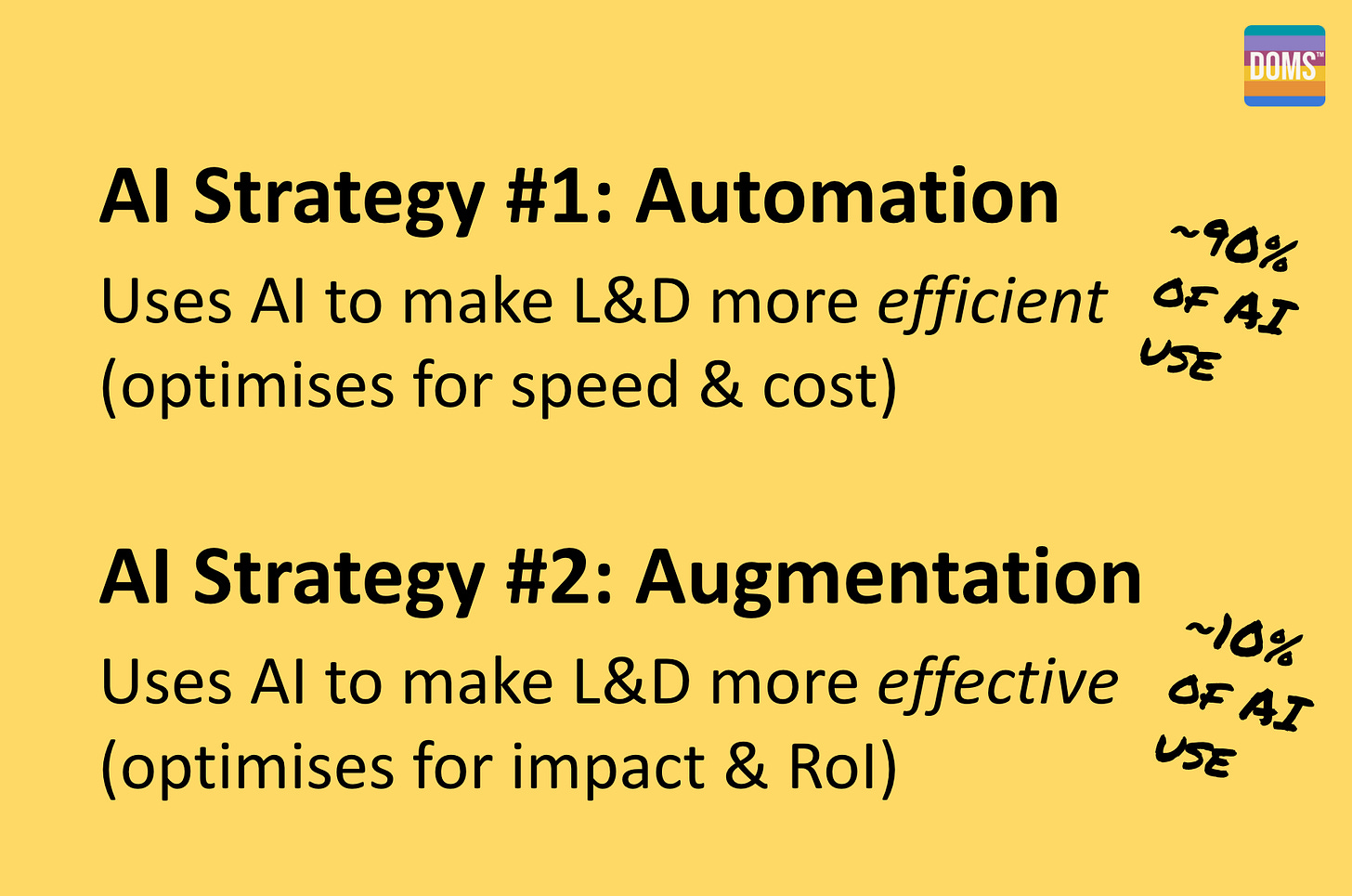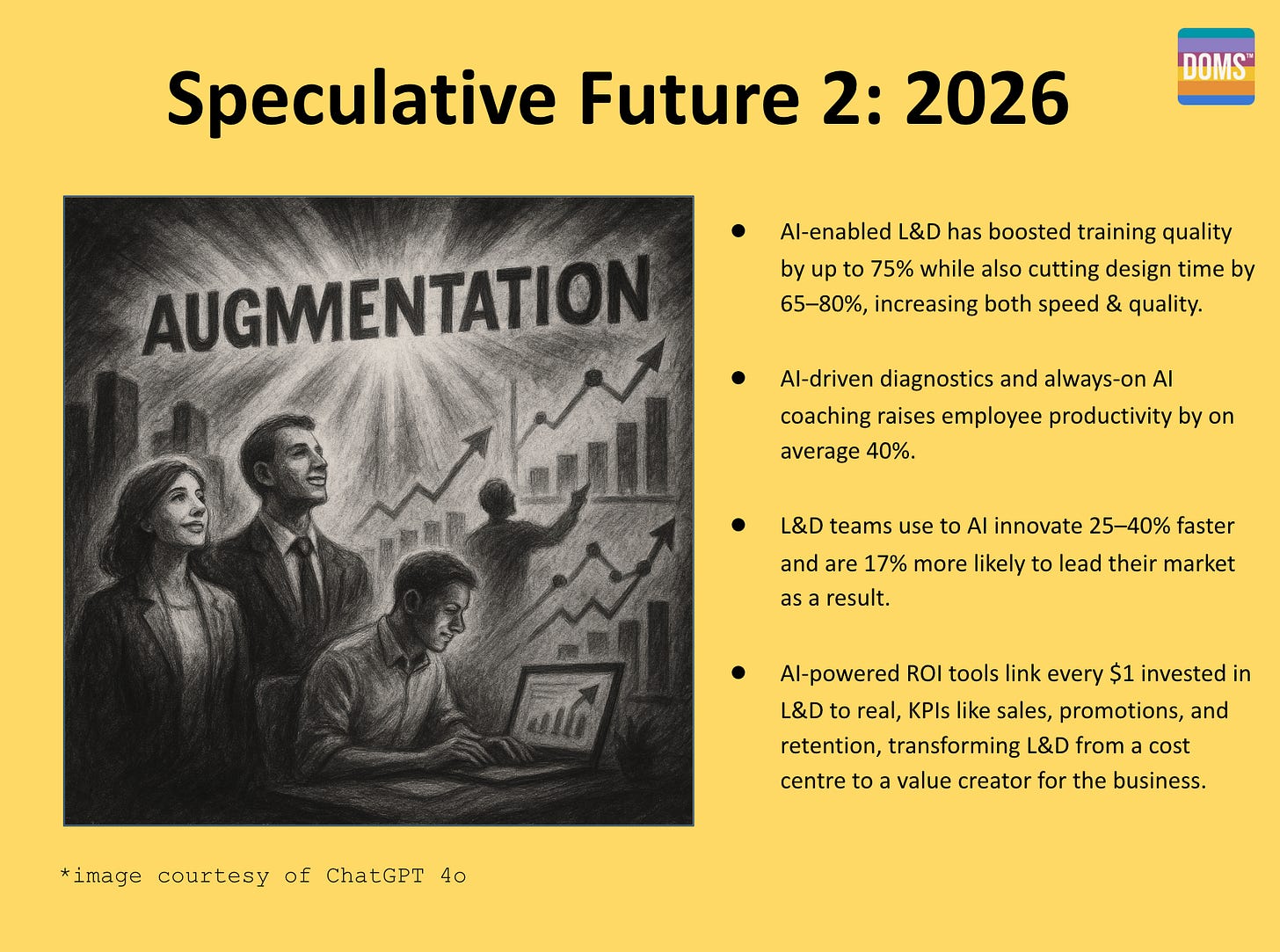AI for Automation or Augmentation of L&D?
An audio summary of my Learning Technologies talk
Hello folks!
Like many of you, I spent the first part of this week at Learning Technologies in London, where I was lucky enough to present a session on the current state of AI and L&D.
In this week’s blog post, I summarise what I covered and share an audio summary* of my paper for you to check out.
Let’s go!
* scroll to the bottom if you want to jump straight to the audio!
AI & L&D: From Automation to Augmentation
During this lively session, my chair and I took the audience on a journey through two types of AI strategies currently at play in L&D:
Automation strategies — using AI to reduce cost and increase the speed of analysis, design, and development. This is by far the most common approach in L&D today, accounting for around 90% of AI applications I see in practice.
Augmentation strategies — using AI to improve the effectiveness of L&D, specifically its impact on both learners and business outcomes.
The Biggest Risk of AI in L&D
Once the landscape was laid out, I shared a spiky point of view: the biggest risk of AI in L&D is that we might use it to scale a fundamentally broken system.
Just along the corridor, hundreds of vendors were showcasing AI tools that promise to turn text into video, images, audio, and even entire course designs in seconds. But what many fail to recognise is that these tools risk scaling a process that, in many cases, doesn’t work.
It’s a tough truth, but the data speaks for itself: only 12% of workplace training has a measurable impact on learners and the business. That means 88% of what L&D produces today has no meaningful effect.
And that brings us to the central question I posed to the group: what kind of future do we want to build for L&D — one that reinforces and scales the status quo, or one that reimagines what learning can be?
To help us to answer this question, I offered two potential futures for the group to consider and compare.
Speculative Futures for L&D
To help answer this question, I invited the audience to explore two speculative futures for L&D in 2026 — both based on trends already underway.
Future 1: AI for Automation
Imagine a world where L&D teams are measured by how fast and cheaply they can deliver, not by the impact they create.
In this scenario, AI is used purely to speed up existing processes. That brings short-term efficiency — maybe even reduced headcount — but leads to long-term damage:
Business: erosion of organisational capability and market leadership
L&D: deskilling, reduced innovation, low productivity
Instructional Designers: deskilling and potential redundancy

Future 2: AI for Augmentation
Now picture a world where AI is used not just for speed and cost — but to improve quality, impact, and real-world performance outcomes.
In this version of the future, AI is a catalyst for transformation, not just a productivity tool. It helps us:
Diagnose more deeply: Mining performance data, role maps, and skill taxonomies to understand not just gaps, but root causes. Case Study: AI-based skills gap analysis at Norsk Hydro
Design with evidence: Collaborating with learning science–tuned AI tools to create personalised, outcome-driven experiences. Case Study: Epiphany AI–enabling evidence-based training design at Haleon
Support in the flow of work: Acting as real-time co-pilots to help employees apply knowledge and grow on the job. Case Study: Agentic-AI teammates at P&G
Evaluate with impact: Connecting learning directly to business KPIs — like productivity, sales, or retention. Case Study: Deloitte’s AI-powered ROI Analyser
In short: augmentation shifts L&D from content producer to capability builder — from a cost centre to a value creator.
For instructional designers, the augmentation path means re-skilling, not de-skilling, taking on new roles which help to co-create and maintain AI systems which optimise employee performance.
Most importantly, augmentation strategies have the potential to solve the most wicked problem of L&D: impact.
Concluding Thoughts
The conclusion? At a time when more and more AI products promise to deliver analysis, design & development faster and cheaper we must stop and ask: how can we also ensure that we are using AI to make L&D better?
Ultimately, AI will not determine the future of L&D — humans will.
To learn more, including case studies from like Norsk Hydro, Deloitte & P&G, check out the audio summary of my talk here:
Happy innovating!
Phil 👋
PS: If you want to hone your L&D skills for the AI world, apply for a place on my bootcamp.







